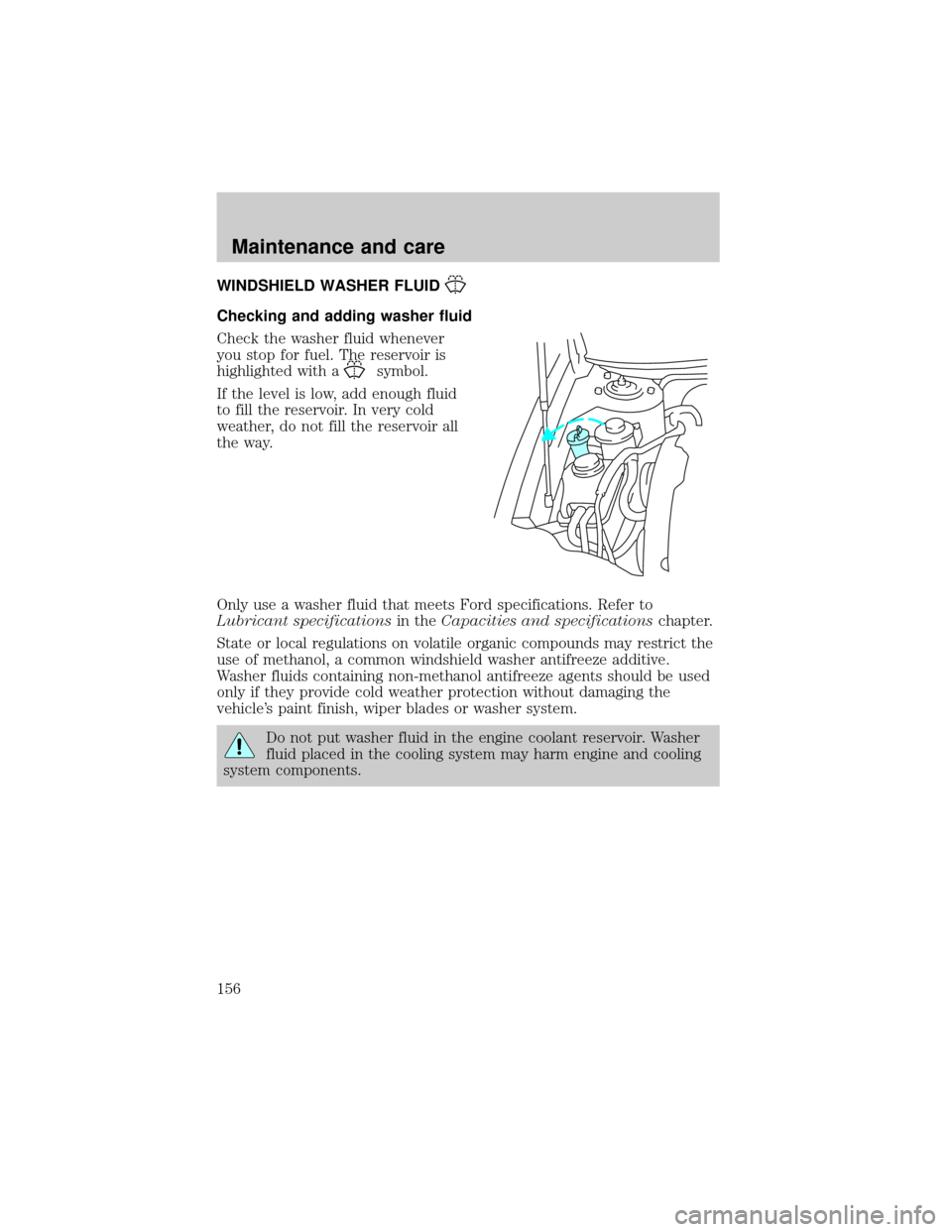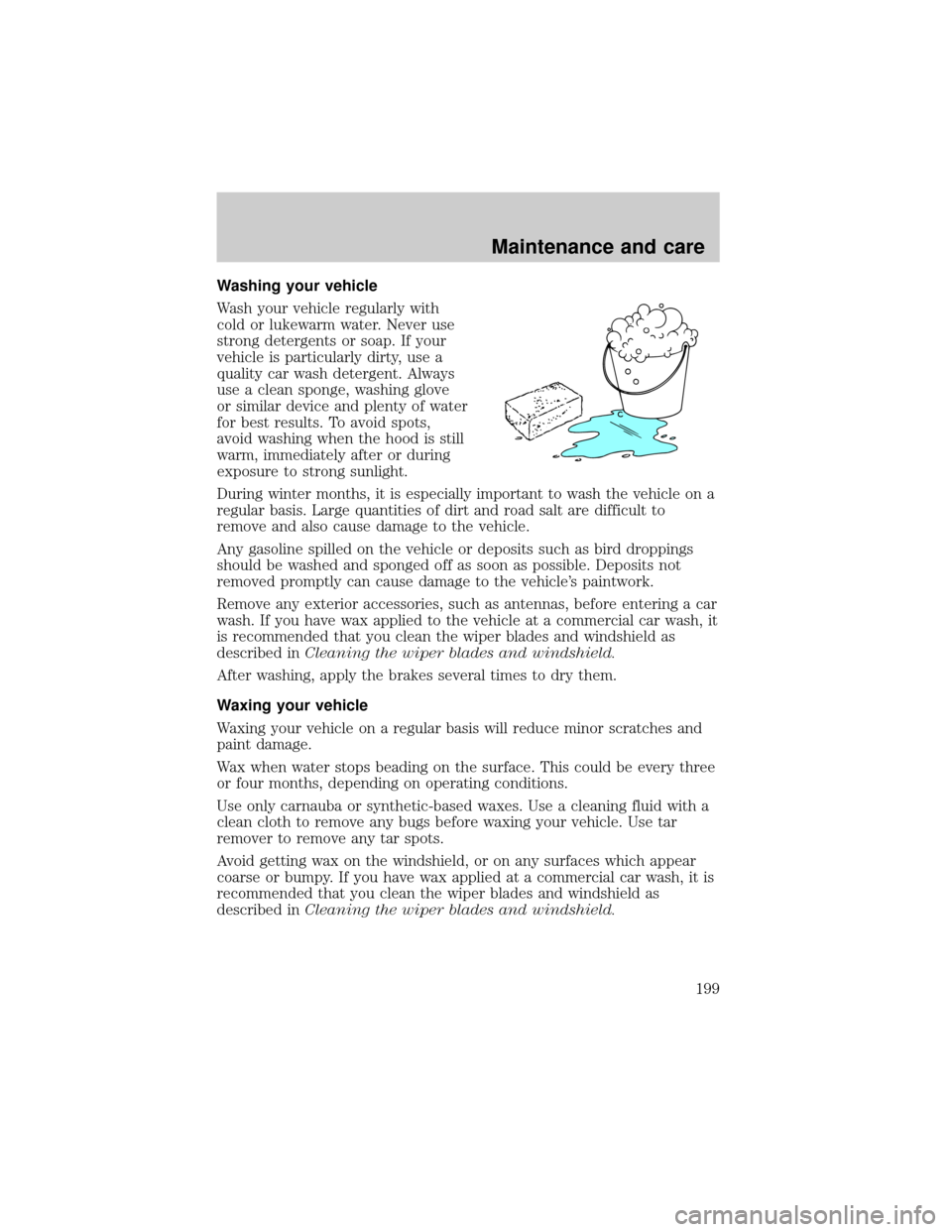2000 FORD TAURUS wiper blades
[x] Cancel search: wiper bladesPage 156 of 232

WINDSHIELD WASHER FLUID
Checking and adding washer fluid
Check the washer fluid whenever
you stop for fuel. The reservoir is
highlighted with a
symbol.
If the level is low, add enough fluid
to fill the reservoir. In very cold
weather, do not fill the reservoir all
the way.
Only use a washer fluid that meets Ford specifications. Refer to
Lubricant specificationsin theCapacities and specificationschapter.
State or local regulations on volatile organic compounds may restrict the
use of methanol, a common windshield washer antifreeze additive.
Washer fluids containing non-methanol antifreeze agents should be used
only if they provide cold weather protection without damaging the
vehicle's paint finish, wiper blades or washer system.
Do not put washer fluid in the engine coolant reservoir. Washer
fluid placed in the cooling system may harm engine and cooling
system components.
Maintenance and care
156
Page 173 of 232

2. Put the gearshift in P (Park), turn off all accessories and start the
engine.
3. Run the engine until it reaches normal operating temperature.
4. Allow the engine to idle for at least one minute.
5. Turn the A/C on and allow the engine to idle for at least one minute.
6. With your foot on the brake pedal and with the A/C on, put the
vehicle in D (Drive) and allow the engine to idle for at least one minute.
7. Drive the vehicle to complete the relearning process.
²The vehicle may need to be driven 16 km (10 miles) or more to
relearn the idle and fuel trim strategy.
²If you do not allow the engine to relearn its idle trim, the idle
quality of your vehicle may be adversely affected until the idle
trim is eventually relearned.
If the battery has been disconnected or a new battery has been installed,
the clock must be reset once the battery is reconnected.
²Always dispose of automotive
batteries in a responsible manner.
Follow your local authorized
standards for disposal. Call your
local authorized recycling center
to find out more about recycling
automotive batteries.
WINDSHIELD WIPER BLADES
Check the wiper blades at least twice a year or when they seem less
effective. Substances such as tree sap and some hot wax treatments used
by commercial car washes reduce the effectiveness of wiper blades.
Checking the wiper blades
If the wiper blades do not wipe properly, clean both the windshield and
wiper blades using undiluted windshield wiper solution or a mild
detergent. Rinse thoroughly with clean water. To avoid damaging the
blades, do not use fuel, kerosene, paint thinner or other solvents.
LEAD
RETURN
RECYCLE
Maintenance and care
173
Page 174 of 232

Changing the wiper blades
To replace the wiper blades:
1. Pull the wiper arm away from the
windshield and lock into the service
position.
2. Turn the blade at an angle from
the wiper arm. Push the lock pin
manually to release the blade and
pull the wiper blade down toward
the windshield to remove it from the
arm.
3. Attach the new wiper to the
wiper arm and press it into place
until a click is heard.
REAR WINDOW WIPER BLADES
Refer toWindshield Wiper Bladesin this section for more information
on rear wiper blades.
INFORMATION ABOUT UNIFORM TIRE QUALITY GRADING
New vehicles are fitted with tires
that have a rating on them called
Tire Quality Grades. The Quality
grades can be found where
applicable on the tire sidewall
between tread shoulder and
maximum section width. For
example:
²Treadwear 200 Traction AA Temperature A
These Tire Quality Grades are determined by standards that the United
States Department of Transportation has set.
Tire Quality Grades apply to new pneumatic tires for use on passenger
cars. They do not apply to deep tread, winter-type snow tires,
space-saver or temporary use spare tires, tires with nominal rim
diameters of 10 to 12 inches or limited production tires as defined in
Title 49 Code of Federal Regulations Part 575.104(c)(2).
Maintenance and care
174
Page 199 of 232

Washing your vehicle
Wash your vehicle regularly with
cold or lukewarm water. Never use
strong detergents or soap. If your
vehicle is particularly dirty, use a
quality car wash detergent. Always
use a clean sponge, washing glove
or similar device and plenty of water
for best results. To avoid spots,
avoid washing when the hood is still
warm, immediately after or during
exposure to strong sunlight.
During winter months, it is especially important to wash the vehicle on a
regular basis. Large quantities of dirt and road salt are difficult to
remove and also cause damage to the vehicle.
Any gasoline spilled on the vehicle or deposits such as bird droppings
should be washed and sponged off as soon as possible. Deposits not
removed promptly can cause damage to the vehicle's paintwork.
Remove any exterior accessories, such as antennas, before entering a car
wash. If you have wax applied to the vehicle at a commercial car wash, it
is recommended that you clean the wiper blades and windshield as
described inCleaning the wiper blades and windshield.
After washing, apply the brakes several times to dry them.
Waxing your vehicle
Waxing your vehicle on a regular basis will reduce minor scratches and
paint damage.
Wax when water stops beading on the surface. This could be every three
or four months, depending on operating conditions.
Use only carnauba or synthetic-based waxes. Use a cleaning fluid with a
clean cloth to remove any bugs before waxing your vehicle. Use tar
remover to remove any tar spots.
Avoid getting wax on the windshield, or on any surfaces which appear
coarse or bumpy. If you have wax applied at a commercial car wash, it is
recommended that you clean the wiper blades and windshield as
described inCleaning the wiper blades and windshield.
Maintenance and care
199
Page 201 of 232

To avoid scratching the lamps, do not use a dry paper towel, chemical
solvents or abrasive cleaners.
Cleaning the wiper blades, windshield and rear window
If the wiper blades do not wipe properly, clean the wiper blade rubber
element with undiluted windshield washer solution or a mild detergent.
To avoid damaging the blades, do not use fuel, kerosene, paint thinner or
other solvents.
If the wiper still does not wipe properly, this could be caused by
substances on the windshield or rear window such as tree sap and some
hot wax treatments used by commercial car washes. Clean the outside of
the windshield or rear window with a non-abrasive cleaner such as Ford
Ultra-Clear Spray Glass Cleaner, (E4AZ-19C507±AA), available from your
Ford Dealer.Do notuse abrasive cleansers on glass as they may cause
scratches. The windshield or rear window is clean if beads do not form
when you rinse it with water. The windshield, rear window and wiper
blades should be cleaned on a regular basis, and blades or rubber
elements replaced when worn.
Cleaning the engine
Engines are more efficient when they are clean because grease and dirt
buildup keep the engine warmer than normal. When washing:
²Take care when using a power washer to clean the engine. The high
pressure fluid could penetrate the sealed parts and cause damage.
²Do not spray a hot engine with cold water to avoid cracking the
engine block or other engine components.
²Cover the highlighted areas to prevent water damage when cleaning
the engine.
Maintenance and care
201
Page 226 of 232

windows ..................................203
wiper blades ............................201
woodtone trim ........................203
Climate control (see Air
conditioning or Heating) ............18
Clock .......................................31,38
Console ........................................56
Controls
power seat .................................75
Coolant
checking and adding ..............157
refill capacities .................161,206
specifications ...................207,208
Cruise control
(see Speed control) ....................44
Customer Assistance ................130
Ford accessories
for your vehicle ......................219
Ford Extended
Service Plan ............................212
Getting assistance outside
the U.S. and Canada ..............218
Getting roadside assistance ...130
Getting the
service you need ....................212
Ordering additional
owner's literature ...................223
The Dispute
Settlement Board ...................215
Utilizing the Mediation/
Arbitration Program ...............218
Daytime running lamps
(see Lamps) ................................16
Defrost
rear window ..............................17
Dipstick
automatic
transmission fluid ...................163
engine oil .................................152
Doors
door ajar warning .......................9
lubricant specifications ..........207Driving under special
conditions
through water .........................124
Emergencies, roadside
jump-starting ..........................142
Emission control system ..........188
Engine ........................................208
check engine/
service engine soon light ...........9
cleaning ...................................201
coolant .....................................157
idle speed control ...................171
lubrication
specifications ...................207,208
refill capacities ........................206
service points ...................150,151
starting after a collision .........131
Engine block heater .................111
Engine oil ..................................152
checking and adding ..............152
dipstick ....................................152
filter, specifications .........154,205
recommendations ...................154
refill capacities ........................206
specifications ...................207,208
Exhaust fumes ..........................112
Floor mats ...................................56
Fluid capacities .........................206
Fuel ............................................178
calculating fuel economy .......184
cap ...........................................181
capacity ...................................206
choosing the right fuel ...........182
comparisons with EPA fuel
economy estimates .................187
detergent in fuel .....................184
filling your vehicle
with fuel ....................178,181,185
filter, specifications .........184,205
fuel pump shut-off switch .....131
gauge .........................................15
improving fuel economy ........184
Index
226
Page 229 of 232

Speed control ..............................44
Speedometer ...............................13
Starting your vehicle .........108,110
jump starting ..........................142
Steering wheel
tilting .........................................49
Tachometer .................................14
Tires ......................138,174,175,176
changing ...........................138,139
checking the pressure ............176
replacing ..................................177
rotating ....................................176
snow tires and chains ............177
tire grades ...............................175
treadwear ................................175
Towing ................................125,176
recreational towing .................128
trailer towing ..........................125
wrecker ....................................147
Traction control ...................43,116
active light ..................................8
Transaxle
automatic operation ...............118
fluid, refill capacities ..............206
lubricant specifications ..........208
Transmission
fluid, checking and adding
(automatic) .............................163lubricant specifications ..........207
Trip odometer .............................15
Trunk ............................58,60,61,72
remote release ..........................57
Turn signal ...............................8,47
Vehicle dimensions ...................208
Vehicle Identification Number
(VIN) ..........................................211
Vehicle loading ..........................123
Ventilating your vehicle ...........112
Warning chimes ...........................13
Warning lights (see Lights) .........8
Washer fluid ..............................156
Water, Driving through .............124
Windows
power .........................................53
rear wiper/washer .....................48
Windshield washer fluid and
wipers
checking and adding fluid .....156
checking and cleaning .....173,174
liftgate reservoir .....................157
operation ...................................47
replacing wiper blades ...........174
Wrecker towing .........................147
Index
229